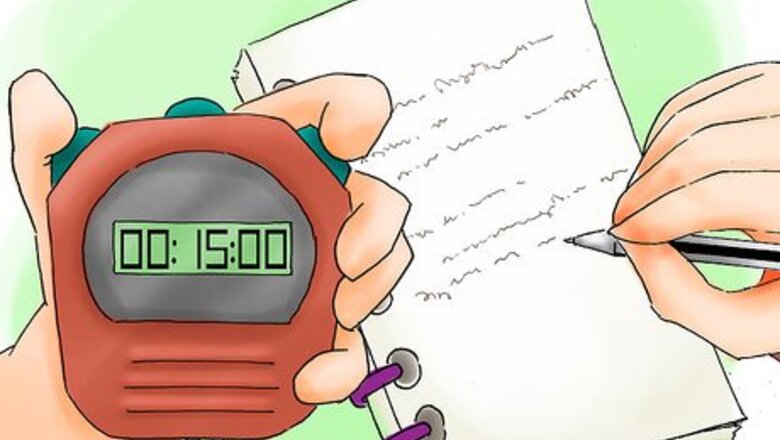
views
Brainstorming Ideas
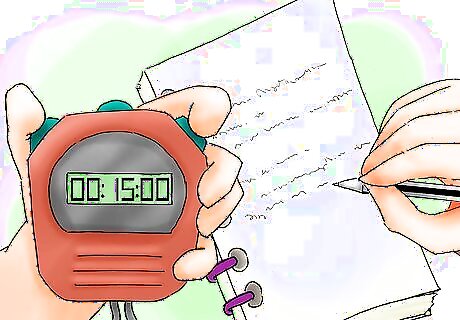
Freewrite for 15 minutes. Get out a pen and a piece of paper or open a new document on your computer. Set a timer for 15 minutes and start writing! Write about anything that comes to mind and do not censor or correct yourself. Even if your mind is blank, write, “My mind is blank” over and over again until you think of something else to write. The most important thing is to keep writing for 15 minutes. When you are finished, look over what you have written to see what you have written. You can then take the most useful sections and expand on these in another timed freewrite. Keep in mind that a freewriting exercise should not be used as a first draft for a paper. Freewriting is a way to generate ideas and the results are often disorganized and chaotic, so submitting a free write as a first draft may result in a bad grade.
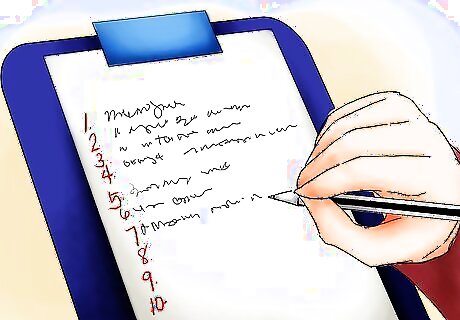
Make a list. Listing can help you to explore possible topics for writing. To use listing, take out a pen and paper or open a new document on your computer and list as many different topic ideas as you can. As with freewriting, do not censor or correct yourself. Add whatever comes to your mind to the list. For example, for a research paper assignment in a composition class, you might write down things like, vertical farming, farm animal welfare, crop rotation, etc. After you have finished your list, identify a few topics that stand out to you and explore these as possible topics for your writing project. Consider how well the topic matches the assignment guidelines, how interested you are in the topic, and how you might refine the topic to suit your needs. When you have chosen a topic, you may also want to do a freewrite on the topic to help you generate ideas and figure out what you already know about the topic.

Create a cluster web. Clustering or mind mapping can help you to explore a topic in more depth, draw connections, and begin to decide how to organize your ideas. Your completed cluster web will look like lots of circles connected by lines. To create a cluster, take out a piece of paper and draw a circle in the center. Then, write your topic in the center of this circle. Next, draw a line extending out from the circle and draw another circle at the end of it. In this circle, write down a sub-topic of your main topic. Continue adding lines extending from your central circle as well as from smaller circles connected to the center circle to build connections among these ideas.

Ask questions. Questioning is another good invention strategy that can also help you to test your topic. Try using “Who? What? When? Where? Why? How?” to determine if your topic idea is worth writing about and to develop ideas on your topic. Consider your topic and then respond in writing to the following questions: Who is affected by this topic? What are the key issues associated with this topic? When did this issue start? Where is the issue occurring? Why is this happening? How can we fix the problem?

Talk to someone about your ideas. Talking about your topic ideas with someone can also help you to test them out and explore what you already know. Talking about your ideas with a friend or teacher can also help you to come up with perspectives or ways of approaching the topic that you had not considered. If you are writing a paper for a course, schedule an appointment with your teacher or professor. You can say something like, "I have some ideas for the next paper and I was hoping to run them by you and see what you think. Are you available to meet before or after class sometime?"

Outline your ideas. Once you have some ideas, you can begin organizing them with an outline. For short papers, you can outline each paragraph individually. For longer works, write out short descriptions of events and organize them according to when they will come in your story. Draw character maps that show how people in the story interact with or feel about each other. Keep in mind that an outline can be as detailed or as scant as you want it to be. For example, you can include a bullet point with a topic sentence for every paragraph with sub-bullets for ideas that you will discuss in the paragraphs, or you can just list the ideas you will discuss in the order that you will discuss them.
Getting in the Mood

Lower your standards. The poet William Stafford once wrote that “there is no such thing as writer’s block for writers whose standards are low enough.” While this might sound awful, the idea that you should be able to sit down as a 5th grader and compose the great American novel is unrealistic. But it is exactly this sort of expectation that leaves people so dissatisfied with their wring that they give up. Great writers compose multiple drafts of their work and have the text reviewed by professional editors. No one expects a first draft to be good. But sitting down and finishing it will give you the chance to see what fits and what does not. From there it will be much easier to improve your ideas. Writing also takes practice. It might take a few failed manuscripts to get it right.

Write every day. To make writing a natural habit, try to sit down at the beginning of every day to write a few pages. If you don't know what to write, start a dream journal. Write about what you dreamed the prior night. This will help you keep in touch with your creative side.

Do some light exercise. People who exercise regularly have been shown to exhibit more creative thinking. If you are struck by writer’s block, a little bit of exercise can distract you from any anxieties that you might have and get your ideas flowing again. Consider going on a walk to clear your head. For more energy, try a short jog. Alternatively, stretch for a couple of minutes to relax yourself.

Drink some coffee. Caffeine increases the effect of chemicals in your brain that naturally produce energy. Consuming caffeine will give you energy and increase your concentration. Thus, it will help you overcome several of the psychological conditions that create writers block, including self-doubt and lack of commitment. Caffeine has other properties that can improve your writing, like increased short term memory and cognitive abilities. The positive effects of caffeine, however, can be negated if it impairs your sleep. Moderate your consumption and drink it early in the day.

Turn on music. Music can increase concentration. It can also inspire emotions that you can spill back onto the page. Depending upon your tastes, loud music might be a distraction. In that case, consider ambient music, possibly without any lyrics. Jazz and classical music are often good ambient music choices for writing.

Find a new location. If you are having trouble focusing in your environment or find it uninspiring, try some place new. A university library has a lot of resources that you can turn to for information. Cafes have coffee and a vibrant atmosphere that can make you feel more comfortable than your own cramped space.

Read. Doing a quick read of some inspirational writing can get you in the mood to do your own. Anyway, a good writer should be reading all the time. It is important to use other writers as point of inspiration and as models for how to write. You also need to read to get a sense for how you can fit your work into existing literature or innovate within a genre of writing.

Eliminate distractions. If TV distracts you, be sure to turn it off. If you live with a bunch of people or along a busy street, do your best to find a place that is less noisy. Consider downloading programs that will remove distractions from your computer. One of the difficulties with writing today is that the best media for composition—your computer—is also rife with distractions of its own. There is, however, specialized software that can change this. Some programs will ration the time you can spend on social media. Writing programs can limit your access to other functions of the computer, so that you can focus exclusively on writing.

Start a routine. Great writers have very different routines. One thing that is almost always true, however, is that they have some sort of routine. You will want to pick a routine that fits your energy level and schedule throughout the day. Once you have a routine, your mind will naturally turn to writing when it is time to sit down and work. For example, Simone de Beauvoir would always begin her days with a cup of tea, review what she had written the previous day, write for several hours, take some time off, and then return to work after dinner. Try to have a designated place and time to work. This sort of routine can create a cue for your brain when it is time to begin work. Perhaps you should always have a cup of coffee or tea before work. Maybe you should always have music on. Perhaps you could eat breakfast directly before writing. Create as many atmospheric cues as possible to tell your brain to get to work.
Writing Your Story
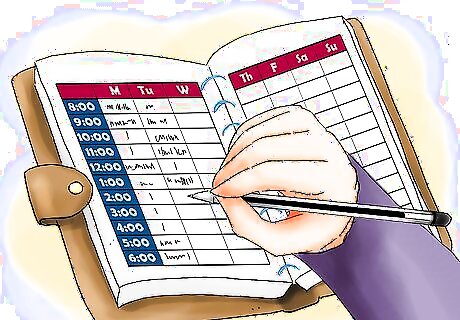
Schedule a time to complete your draft. Drafting can be a difficult part of the process, even if you have lots of ideas. The best thing to do is to set aside some quiet time to do nothing but write. For example, you might plan to do nothing but work on your draft between 8pm to 10pm on Thursday evening. Make sure that you give yourself at least two hours to sit and write your draft. Turn off your cell phone, ask your parents or roommates not to disturb you, and eliminate any other potential distractions. Gather all of your notes from your invention exercises before you begin writing. If you have completed a couple of invention exercises, then you should have a good idea of where to begin and how to organize your thoughts. If not, then you may want to spend some time outlining before you get started.

Spend plenty of time on your introduction. Introductions can be difficult to write, so it is a good idea to spend some extra time thinking about what you want to include in your introduction. You should also make sure that you avoid some of the most common pitfalls with introductions. Try to write an introduction that will draw your readers into the story and help them connect with your topic. You might begin by asking a question, giving an illustrative example, or explaining a difficult concept. Avoid giving broad history in your intro. Introductions sometimes go too wide and this can be confusing for readers. Avoid starting your paper with phrases like, "Since the dawn of time..." or "Everyone in the history of mankind..." or " Avoid providing dictionary definitions. Intros that include a definition are often dull and the definition is not usually necessary at all. Avoid starting your paper with phrases like, "The dictionary defines friendship as..." or "According to Webster's dictionary..."
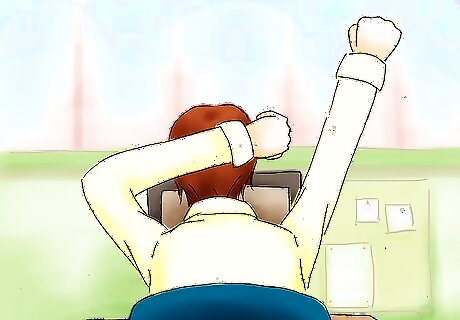
Take breaks. Some people prefer to write a draft while others need to do it in small chunks. Decide what works best for you, but make sure to give yourself breaks about every two hours. It is hard to concentrate for more than two hours at a time, so get up stretch, take a quick walk, or grab a snack after you have been working on your draft for a while.

Get feedback. After you have completed your first draft, find someone to give you feedback on what you have written. You can ask a teacher, friend, or parent to read your work. If the reader is not familiar with your assignment or other purpose for writing, let him or her know what it is. For example, if you ask a friend to read your paper, tell him or her what class the paper is for, what the assignment requirements are, and what (if any) particular concerns you have about what you have written. Most universities have writing centers where students can drop in or schedule an appointment to meet with a writing tutor for free. A writing tutor can read your paper and help you identify ways to improve your work.

Revise your work. After you receive feedback, set aside some time to revise you work. As with drafting, you should set aside about two hours to revise your work. Keep in mind that revising is not the same as proofreading. Proofreading is the final step in the writing process where you identify minor errors and make your paper look polished. Revising is when you look at your paper with a fresh perspective and consider how you can make it better. To revise, you may have to delete, add, reorder, reorganize, or expand existing paragraphs in your draft. As you revise, make sure that you address any areas for improvement that your readers have identified for you. You should also read over your work yourself and look for areas that would benefit from more details, better sources, or a tighter focus. Remember that writing is a process and it is often cyclical. Sometimes revision may require you to add a significant amount of text to fully explain a concept or to strengthen an argument. To do this, you may need to return to the invention stage. If possible, take a break between drafting your paper and revising it. Taking at least a few hours or a few days between drafting and revising will help you to see your paper with fresh eyes. This will make it easier to identify problems and their solutions.
Practicing in Different Formats

Start a blog. A blog can be a great place to put out your writing in a place where it will get read. People’s responses can help you learn and grow as a writer. You might even get some name recognition. Try doing an interview. Ask a prominent person if they are willing to talk to you. You might be surprised who would be willing to talk to you for a bit of additional publicity. Such a big name can bring in new readers.
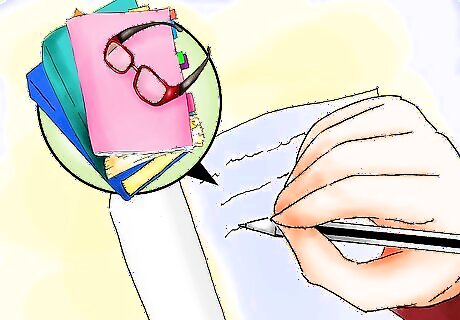
Write book reviews. Review a book and send the review off to local newspapers or websites that are interested in the subject. These will give you an opportunity to get your name in print. Furthermore, engaging in a deep way with the work of a great writer will give you some perspective on your own creative endeavors.

Do piece work. Writing short pieces for magazines, websites, and newspapers might not be what you want to do with your life. However, it will give you some name recognition and a bit of money to help you live the life of a writer. Most importantly, working on a time table under experienced editors will get you accustomed to the pace and style of professional writing.



















Comments
0 comment